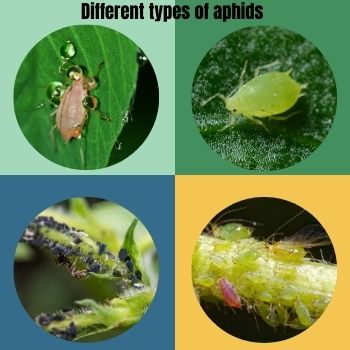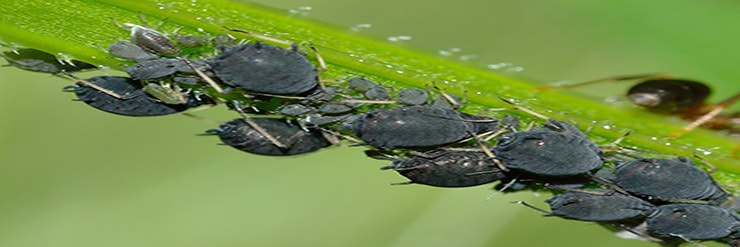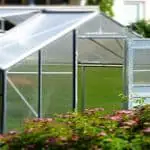Aphids are tiny, sap-sucking pests that can cause extensive damage to plants. Greenhouses are especially vulnerable to aphid infestations, as the warm and moist environment is ideal for their growth. In this blog post, we’ll discuss how to get rid of aphids in a greenhouse using natural methods. Keep reading for more information!
There are a few ways to get rid of aphids in a greenhouse. It is best to use more natural solutions to an aphid problem inside your greenhouse. One is to use a soap solution. Another is to use essential oil. You can also use neem oil to safely and naturally remove an aphid problem
If you have an aphid problem in your greenhouse then you will need to find out the best ways to naturally remove them from your greenhouse without using chemicals or other means that may spoil the crops in your greenhouse. Read on to find the best ways that are all suitable for your greenhouse!
- How to get rid of aphids in a greenhouse
- How to naturally get rid of aphids in your greenhouse
- How to get rid of aphids permanently in your greenhouse using aphid predators
- How to get rid of aphids on tomato plants in your greenhouse
- How to get rid of aphids on strawberry plants in your greenhouse
- Knowing what to plant to help your efforts to rid aphids in a greenhouse
- Signs of an aphid problem
- Can plants recover from aphids
- Conclusion
How to get rid of aphids in a greenhouse
Aphids will ruin your greenhouse plants if you don’t get rid of them quickly. They will suck the sap out of the leaves and stems, causing the plant to wilt and die.
If you have an infestation of aphids in your greenhouse, there are a few things you can do to get rid of them.

First, try to introduce beneficial predators into your greenhouse. Ladybugs and green lacewings are two good options.
You can also try spraying the plants with a mixture of water and soap, or with insecticidal soap.
If all else fails, you can use a chemical insecticide. Be sure to follow the instructions on the label carefully, and only use the insecticide as a last resort.
Got an aphids problem in your greenhouse? no problem!
While there are many chemicals and pesticides available to kill aphids, these can be harmful to both your plants and the environment, and the food you are growing in your greenhouse.
Luckily, there are a few simple and natural ways to get rid of aphids for good.
The ones we will look at are all suitable for getting rid of aphids permanently in a greenhouse.
Let’s take a closer look at some of these methods for ridding a greenhouse of aphids
How to naturally get rid of aphids in your greenhouse
You can use chemical pesticides to kill aphids, but these can also harm beneficial insects, pollinators, and other animals. Also, you may be growing food inside your greenhouse, so you don’t want to use anything that could potentially contaminate your crops.
Luckily, there are some natural ways to get rid of aphids.
Below I have listed three natural ways that you can get rid of an aphid problem in your greenhouse without harming your plants and vegetables.
Use a natural aphid spray vinegar with dish soap

Sprays are a common means of aphid control as well, water and soap solutions are generally used for these purposes in greenhouses affected by aphids. By mixing a few tablespoons of soap into a water solution and being careful to spray both the tops and bottoms of the leaves can help with the aphid infestation.
Soaking the leaves in this situation might help as well. You can buy pre-mixed sprays for aphid control at most lawn and garden retailers, though doing your research on the components of these can really make a difference in the long-term life and quality of your plants.
You’ll need:
Dish soap (Amazon link)
White vinegar (Amazon link)
Spray bottle (Amazon link)
How to use a natural aphid spray with vinegar and dish saop:
By mixing a few tablespoons of dish soap, a cup of white vinegar to about a quart of water you’ll have your very own homemade DIY aphid control spray
Be sure to fully cover in soapy water making sure under the leaves and stems are all covered – repeat every few days
how to get rid of aphids with essential oils
Oils are also a great alternative for aphid management. Essential oils like clove, peppermint, and thyme can be mixed into a spray solution at a few drops to a bottle ratio. With this method, it’s important to ensure the spray solution saturates the plant and all the insects, including larvae and eggs.
You’ll need:
Peppermint oil (Amazon link)
Clove oil (Amazon link)
Rosemary oil (Amazon link)
thyme oil (Amazon link)
Spray bottle (Amazon link)
How to get rid of aphids with essential oils:
Add 5 or 6 drops of each of the essential oils into the spray bottle filled with water and spray all the infested plants thoroughly, making sure to spray under the leaves too.
Using Neem Oil for Aphid Control
Outside of this, neem oil can also make a huge difference in your aphid management plan, and help with other bug problems as well.
Neem oil, when accurately diluted, can help with repelling aphids, mealworms, beetles, and caterpillars. Just add a few drops to
Using neem oil as a repellent for aphids is a very common pest control solution as it not only acts as an insect killer but also a fungicide too. A lot of repellents you might buy online use neem oil to help solve aphid infestations
You’ll need:
100% Pure neem oil (Amazon link)
Dish Soap (Amazon link)
Spray bottle (Amazon link)
How to use Using Neem Oil for Aphid Control:
First, you will need to make dish soap and water mix and add some neem oil. Being an oil, It won’t mix in the water correctly – start by adding two tablespoons of dish soap to about a gallon of water, mix and then add two tablespoons of neem oil and mix thoroughly.
How to get rid of aphids permanently in your greenhouse using aphid predators
One of the most common pests in greenhouses is aphids. These small, pear-shaped insects can quickly multiply and infest your plants. While there are many chemicals that can kill them, these can also be harmful to your plants and the environment.
A better way to get rid of aphids is to introduce their natural predators into your greenhouse.

Aphid predators are small, beneficial insects that feed on aphids. Some of the most common aphid predators include ladybirds, lacewings, and parasitic wasps. You can purchase these insects from a garden center or online retailer. Once you have them, release them into your greenhouse according to the instructions.
These predators will help keep the aphid population under control and help prevent future infestations in your greenhouse.
Related article:
How to get rid of aphids on tomato plants in your greenhouse
Aphids are tiny pests that can wreak havoc on your tomato plants. While there are many chemicals you can use to kill them, there are also some natural methods that will get rid of them for good.
One way to get rid of aphids is by using a strong stream of water from your hose. Aim the hose directly at the aphids and blast them away.

You can also try using a mixture of DIY insecticides. Some good ways on how to naturally get rid of aphids are listed above, but they include:
- Use a natural aphid spray vinegar with soap
- How to get rid of aphids with essential oils
- Using Neem Oil for Aphid Control
- How to get rid of aphids permanently in your greenhouse using aphid predators
How to get rid of aphids on strawberry plants in your greenhouse
If you’re noticing small, soft-bodied insects on your strawberry plants, chances are they are aphids. Aphids can damage leaves and stunt plant growth, so it’s important to get rid of them as soon as possible.
There are a few different ways to get rid of aphids in your greenhouse.
One option is to introduce beneficial predators, such as ladybugs or lacewings, into the environment. These predators will feed on the aphids, naturally controlling their population.
You can also remove aphids by spraying them with water from a hose or with an insecticidal soap solution.
If you go the chemical route, be sure to follow the instructions on the product label carefully.
With a little effort, you can keep aphids from damaging your strawberry plants. By taking action quickly and using the right method for your greenhouse, you can get rid of these pests for good.
Knowing what to plant to help your efforts to rid aphids in a greenhouse
Just like there are many solutions you can employ to help with managing your bug problem, there are tons of plants you can sprout to help the effort. Growing the right plants makes all the difference in a struggling garden.
To begin, it’s important to make sure that all efforts centered around managing the insects you don’t want don’t affect the insects you do want in your plots. Beneficial bugs can be hugely disrupted by insecticides and sprays, so means of attracting them can be of the utmost importance. Plants like clover, dill, mint, and fennel can attract bugs that can act as predators for aphids and their offspring.

In contrast, a few plants can act as repellents for predatory bugs like aphids. Sprouts of catnip, garlic, onions, and chives can make it difficult for aphids to settle, allowing for a more natural and hands-off solution to your bug problem.
Plants can also be used for luring and trapping unwanted aphid infestations. Aphids are naturally attracted to plants with nodes and stem-like roses, dahlias, cosmos, and mustard plants. These can be used as a sort of aphid sacrifice to lure them away from plants you are trying to protect. While alone this is not a solution that rids you of aphids, this method allows for a management solution that can be more effective when used with other means.
Signs of an aphid problem
The most common signs are wilted and dying leaves that are turning yellow, misshapen produce, and deformed flowers. While most aphids feed on almost anything with a sweet sap, some are specific to certain plant groups.
An ant trail can sometimes alert you to the presence of aphids, since they can live in a sort of symbiotic relationship with them to collect food in exchange for protection from predators.
Aphids can feed on a variety of different plants, fruits, and vegetables and there are a few tell-tale signs for an aphid infestation.
These tiny little creatures might not be visible at first so be sure to thoroughly check under the leaves and down the stems.
As they love to feed on the sap, if you notice these places are particularly sticky, this could be another sign that aphids have been there.
Roses and other flowers are huge targets of an aphid infestation. Rose hips and buds can be attacked in a matter of just a few days, and generations of aphids in these conditions can be established within a season.
There are also variations of root aphids, which just as the name suggests, attack and feast on certain rooted vegetables and other sweet roots. While these kinds of aphids can prove more difficult to see and equally as difficult to treat, their tells are the same. Wilting produce, damage to the leaves and flowers, and misshapen root systems may all be identifiers for these elusive and difficult pests.
Can plants recover from aphids
These plant parasites can cause tremendous damage to the healthy growth of your plants, essentially sucking the life from them. Aphids love to feast on a range of plants, vegetables, roots, and herbs such as tomato plants, roses, pepper plants, and any other of your precious crops.
There is some good news, once you have controlled, even a severe case of an aphid pest problem your plants should make a full recovery under the correct growing conditions and even bear fruit once again.
Conclusion
We looked at the many ways how to get rid of aphids in a greenhouse using natural methods.
Aphids and other pesky insects can be managed and controlled by means of a few different solutions. The effort of insect control can be a difficult and daunting task, but recognizing the needs of your plants and the availability of these methods is up to you, though researching as much as possible will help aid the decision.
Aphids and other predatory bugs can be a nuisance easily managed with time and patience, and the results can prove worth the trouble in the end. It’s all about what works best for you and your greenery.






